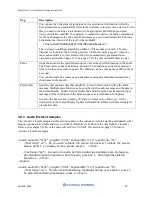
MoniPlus2 Voice Guidance Configuration Guide
April 29, 2014
5
3 VG Transaction Processing
This section discusses any differences, or possible differences, that can be included in the messages
between the ATM and the host for VG transactions. Use this information when planning how to
implement VG for your host download.
3.1 Transaction Request Messages
Voice guided transactions can optionally be identified in the transaction request message to the host.
When this feature is desired, there are two methods that can be used:
•
Opcode identifier – a value can be placed in the opcode buffer to identify a VG session to the host.
The byte position and character are defined within the VG XML file. Refer to the
on page 8 for more information on this option.
•
Appended character – a <, or other character, can be added to the end of the transaction request
message to identify a VG transaction to the host. Refer to the
on page 8 for
more information on this option.
Verify that your host application can support the option you select before you implement either addition
to the transaction request message.
3.2 Transaction Reply Messages
You can specify an audio message to be voiced, or include dynamic data to be voiced, in your transaction
reply message. You can use the Screen Display Update field for this purpose, or you can use the printer
data field in the message. Refer to the
Sending VG Data in Authorization Messages
section on page 22 for
detailed information on this feature.
3.3 Interactive Transaction Response Messages
When additional information needs to be gathered from the customer, the host can send data to be voiced
in an Interactive Transaction Response (ITR). This dynamic VG data is placed in the Screen Display Data
field of the ITR message. There are two ways to use this field to send VG data to be voiced: Direct Audio
Text and Indirect Audio ID. Refer to the
VG Data in Authorization Messages
section on page 22
for detailed information on these options.










































